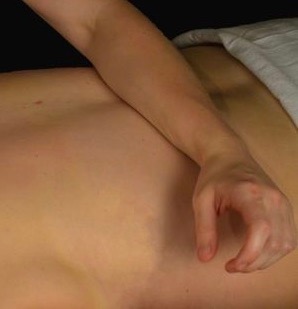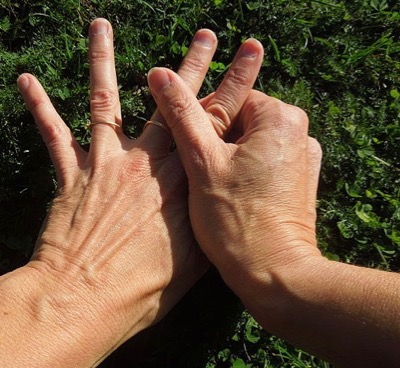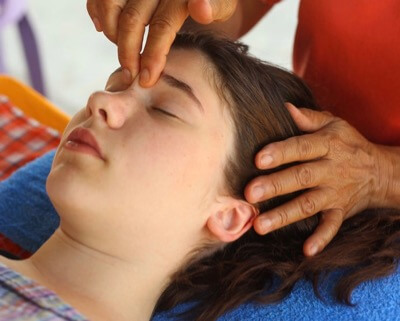Tui na massage (pronounced ‘twee-nah’ and sometimes spelled tuina) is a type of deeply penetrating Chinese massage that includes a series of pressing, rolling, tapping, and kneading techniques. Tui means “push” and na means “grasp.”
Chinese Tui Na Massage: The Essential Guide states the massage uses manipulations of acupoints and other body surfaces to stimulate the body to correct physiological imbalance, promote healing, and return body functions to normal. Tuina aims to restore balance by increasing or decreasing, as appropriate, the body’s function to counter either excess or deficiency in the body.
Common causes of excess in modern society include stress, overwork, and overindulgence (in food or any activity). Deficiencies often result form poor diet, lack of sleep, and not enough exercise. Both excesses and deficiencies interfere with the the energy flow called qi.
The massage frees blocked energy and enhances flow of qi through the body’s energy pathways (the meridian system that consists of 14 main channels plus smaller branches called collaterals) of the body. The massage is one part of the larger system of Traditional Chinese Medicine (TCM).
A trained tui na practitioner must know how to use the proper hand techniques, understand TCM theory and how it applies, know and understand locations and functions of acupoints and channels, have knowledge of western anatomy, and know and understand appropriate assessment and treatment skills.
Benefits and Techniques
The movement of qi shows up as changes in muscle and fascial tone,
circulation of blood and fluids, and sensations such as tingling or
warmth. Massage techniques focus on freeing blocked energy to relieve pain
and let the body heal itself. The massage is considered especially
effective for helping relieve chronic pain, musculoskeletal conditions
(such as neck, shoulder, back, sciatic, and joint pain), and
stress-related conditions affecting the digestive or respiratory system.
Techniques include massage of muscles and tendons, stimulation of
acupressure points to directly affect the qi flow, and techniques to
realign muscles, bones, and ligaments. Although some of the massage
techniques are similar to Swedish massage, they are done with the
intention of harmonizing yin and yang.
To receive the massage, you typically wear loose clothing and no
shoes and lie on a table or a mat on the floor. The practitioner uses a
specific treatment protocol based on your specific problems. The
practitioner may also use compresses, external herbal poultices,
liniments, and salves, as well as cupping and moxibustion (burning a
herb called moxa). The techniques are vigorous and may cause some discomfort.
Tui Na Systems
Different systems of tuina focus on particular aspects of the therapeutic principles. In China, the main systems include:
- The rolling method focuses on the use of soft tissue techniques, especially for muscle sprains and joint injuries.
- The Nei Gung method uses exercises to generate qi and specific methods of massage to stimulate drained energy systems.
- The one-finger pushing method uses acupressure techniques and focuses on treating internal diseases.
- The bone setting method realigns the muscles, bones, and ligaments and focuses on helping heal joint injuries and nerve pain.
Note that some of these techniques go beyond the scope of massage therapy and cannot be practiced by a typical massage therapist. However, the massage aspects are quite powerful and appropriate even for children. See Tui Na Massage for a Healthier, Brighter Child for more information.
What Is Tui Na Massage – Sources and More Information
“ABT Form | Tuina.” American Organization for Bodywork Therapies of Asia (AOBTA). Retrieved January 27, 2023. https://aobta.org/page/Tuina.
Kovach, Vesna Vuynovich. “The Tui Na Touch: The Intensity of Chinese Medicine at Your Fingertips.” Massage & Bodywork, April/May 2003, pp. 23–29.
Mercati, Maria. The Tui Na Manual: Chinese Massage to Awaken Body and Mind, Healing Arts Press, 2018.
Pritchard, Sarah. Chinese Massage Manual, New Age Books, 2003.
Serviss, Naomoi. “Tui Na: Asia’s Medical Massage.” Massage Magazine, Sept/Oct 2005, pp. 99-102.
“Tuina.” Acupuncture Today. Retrieved January 27, 2023. https://www.acupuncturetoday.com/abc/tuina.php.



